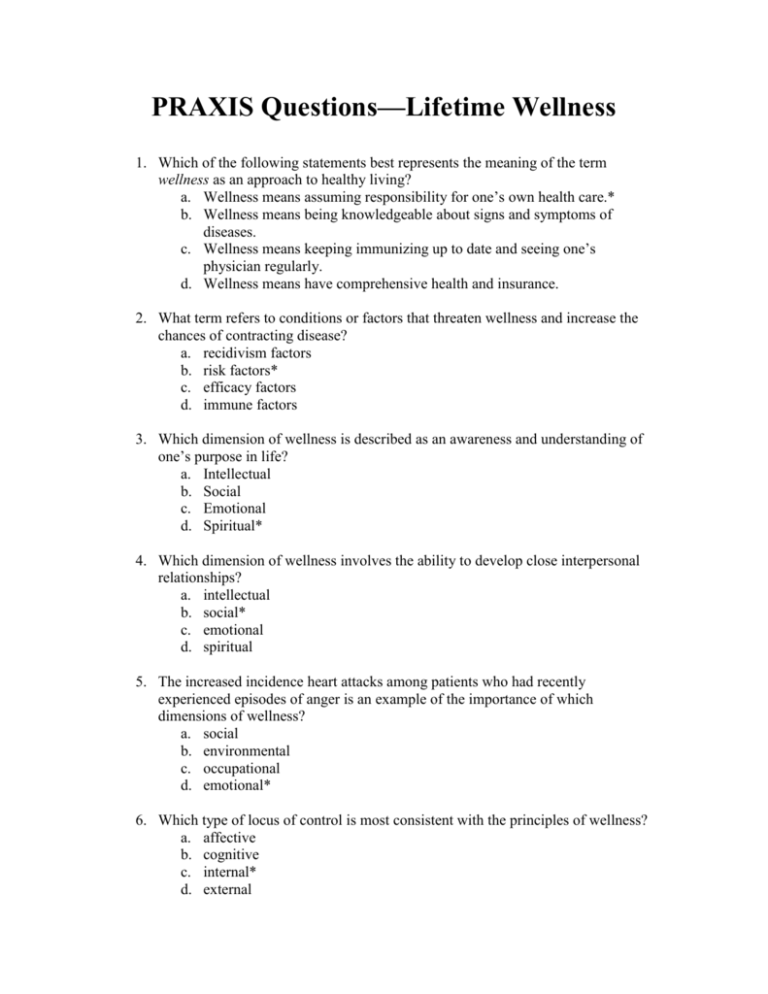PRAXIS Questions—Lifetime Wellness
advertisement

PRAXIS Questions—Lifetime Wellness 1. Which of the following statements best represents the meaning of the term wellness as an approach to healthy living? a. Wellness means assuming responsibility for one’s own health care.* b. Wellness means being knowledgeable about signs and symptoms of diseases. c. Wellness means keeping immunizing up to date and seeing one’s physician regularly. d. Wellness means have comprehensive health and insurance. 2. What term refers to conditions or factors that threaten wellness and increase the chances of contracting disease? a. recidivism factors b. risk factors* c. efficacy factors d. immune factors 3. Which dimension of wellness is described as an awareness and understanding of one’s purpose in life? a. Intellectual b. Social c. Emotional d. Spiritual* 4. Which dimension of wellness involves the ability to develop close interpersonal relationships? a. intellectual b. social* c. emotional d. spiritual 5. The increased incidence heart attacks among patients who had recently experienced episodes of anger is an example of the importance of which dimensions of wellness? a. social b. environmental c. occupational d. emotional* 6. Which type of locus of control is most consistent with the principles of wellness? a. affective b. cognitive c. internal* d. external 7. The term that refers to a person’s belief in his or her ability to accomplish a task is: a. locus of control b. self-efficacy* c. contingency management d. affective involvement 8. Self-efficacy is to behavior as locus of control is to which of the following? a. knowledge b. will power c. attitude* d. potential 9. Which dimension of wellness is described as the ability to balance work, school, leisure, and career goals? a. intellectual b. social c. environmental d. occupational* 10. Which of the following statements best describes the nature of health problems in the U.S. today? a. New strains of exotic diseases present the greatest threat to health today. b. The major problems of today result from poor sanitation, toxic wastes, and the environment. c. Poor nutrition causes most of today’s health problems. d. Today’s major health problems are caused by lifestyle habits and practices.* 11. Which of the following are psychosomatic diseases? a. Diseases that are caused by mistakes made by medical care providers. b. Diseases that are caused by the effects of mental and emotional stressors.* c. Diseases that are transmitted from animals to humans. d. Diseases that can be diagnosed but have no cure. 12. How do chronic diseases differ from acute diseases? a. Chronic diseases usually have a sudden onset, whereas acute diseases typically begin more gradually. b. Chronic diseases often have multiple causes, whereas acute diseases often have specific identifiable causes.* c. Chronic diseases usually disappear in a short time, whereas acute diseases often persist for an indefinite period. d. There is no difference between chronic and acute disease according to the CDC. 13. What risk factor is the most formidable wellness challenge for Americans of all ages? a. sedentary lifestyles* b. excessive dietary fat intake c. failure to wear automobile seat belts d. overweight or obesity 14. Identify in rank order, from highest to lowest, the three risk factors most strongly associated with premature death and chronic disease among all people in the U.S. a. motor vehicles, firearms, and alcohol b. poor diet or lack of exercise, infectious agents, and pollutants or toxins c. alcohol, motor vehicles, and sexual behavior d. tobacco, poor diet or lack of exercise, and alcohol* 15. What is the correct order of the stages of transtheoretical model of behavior change? a. precontemplation, preparation, contemplation, action, maintenance, and termination b. precontemplation, contemplation, preparation, action, maintenance, and termination* c. precontemplation, action, contemplation, preparation maintenance, and termination d. preparation, precontemplation, action, maintenance, contemplation, and termination 16. Which of the following does the American Heart Association classify as a major modifiable risk factor for heart disease? a. Obesity* b. High blood insulin levels c. High serum homocysteine levels d. Stress 17. The American Heart Association suggests that Americans restrict cholesterol consumptions to less that what amount per day? a. 100 mg b. 300 mg* c. 500 mg d. 1000 mg 18. If someone has a total blood cholesterol level of 250 mg/dL., what is their risk of cardiovascular disease? a. Low risk b. Average risk c. Mild risk d. High risk* 19. Which of the following combinations of cholesterol, low-density lipoprotein (LDL), and high-density lipoprotein (HDL) levels suggest the lowest risk of cardiovascular disease? a. Low cholesterol level, high LDL level, and low HDL level b. High cholesterol level, high LDL level, and high HDL level c. Low cholesterol level, low LDL level, and high HDL level* d. Low cholesterol level, low LDL level, and low HDL level 20. Which of the following is most likely to raise high-density lipoprotein levels? a. Anabolic steroids b. Physical exercise* c. Obesity d. High triglyceride levels








